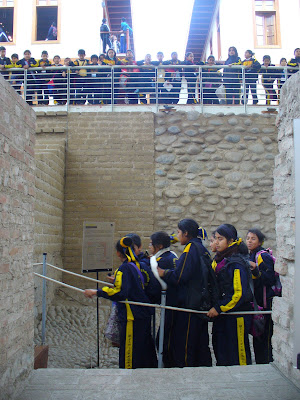
On our trip to downtown this afternoon we took the opportunity to visit the recently opened museum at the Bodega y Quadra House, next to the old train station behind the Presidential Palace. The house, or rather its remains, was the home of the Bodega y Quadra family in the 17th and 18th Centuries. The patriarch of the family, Tomas de la Bodega y Quadra, purchased the property after the devastating earthquake of 1746. The house, like so many others, had been damaged and thus the property was available at a fraction of its previous value. Bodega y Quadra, nontheless, felt that it held promise, as its central location offered advantages given his commercial ventures.
 |
| Lima in 1685 |
Tomas, who was born in Spain, married the limeña Francisca de Mollinedo y Lozada Agüero. Together they had three children: Tomas Aniceto, Alberto, and Juan Francisco. It is the latter of these who brought fame to the famil;y and made the site historically significant, in addition to being so archaeologically.
 |
| Remains of the colonial-era structure |
 |
| Colonial-era floor |
Juan Francisco (1744-1794) upon reaching adulthood he entered the Spanish Royal Navy at Cadiz, whereupon he was detached to the Pacific fleet attached to the Viceroyalty of New Spain at San Blas, Mexico.
In 1775, Juan Francisco Bodega y Quadra was put in command of the Sonora (also called the Felicidad), one of a two-vessel expedition sent by the Spanish crown to explore and lay claim to North America's northern Pacific coast, in light of Russian advances across the Bering Strait.
After the expedition leader, Bruno de Heceta, turned back after an attack by Quinault Indians in present-day Washington state, and the onset of scurvy amongst the crew, Bodeda y Quadra continued northward, eventually reaching the neighborhood of present-day Sitka, Alaska.
Bodega y Quadra was thus able to draw the first relatively accurate maps of the Pacific Northwest coast. In the process, he sailed over and noted the location of a reef that now bears the name of his ship, the Sonora, discovered what we today call Vancouver Island, as well as the bay in California that now bears his name: Bodega Bay.
 |
| The museum is evidently a popular school field trip. |
The Bodega y Quadra home itself was remodeled, torn down, built-over, several times in the intervening centuries, housing, over time, a butcher shop and cobblers, among others. In recent years, the Municipality of Lima took an interest in the site and funded its archaelogical excavation and the establishment of a site museum, which just opened earlier this year.
 |
| Colonial clay pipe bowl |
 |
| Colonial stoneware jars and bottles |




No comments:
Post a Comment